The conserved sex regulator DMRT1 recruits SOX9 in sexual cell fate reprogramming
- PMID: 34096593
- PMCID: PMC8216462
- DOI: 10.1093/nar/gkab448
The conserved sex regulator DMRT1 recruits SOX9 in sexual cell fate reprogramming
Abstract
Mammalian sexual development commences when fetal bipotential progenitor cells adopt male Sertoli (in XY) or female granulosa (in XX) gonadal cell fates. Differentiation of these cells involves extensive divergence in chromatin state and gene expression, reflecting distinct roles in sexual differentiation and gametogenesis. Surprisingly, differentiated gonadal cell fates require active maintenance through postnatal life to prevent sexual transdifferentiation and female cell fate can be reprogrammed by ectopic expression of the sex regulator DMRT1. Here we examine how DMRT1 reprograms granulosa cells to Sertoli-like cells in vivo and in culture. We define postnatal sex-biased gene expression programs and identify three-dimensional chromatin contacts and differentially accessible chromatin regions (DARs) associated with differentially expressed genes. Using a conditional transgene we find DMRT1 only partially reprograms the ovarian transcriptome in the absence of SOX9 and its paralog SOX8, indicating that these factors functionally cooperate with DMRT1. ATAC-seq and ChIP-seq show that DMRT1 induces formation of many DARs that it binds with SOX9, and DMRT1 is required for binding of SOX9 at most of these. We suggest that DMRT1 can act as a pioneer factor to open chromatin and allow binding of SOX9, which then cooperates with DMRT1 to reprogram sexual cell fate.
© The Author(s) 2021. Published by Oxford University Press on behalf of Nucleic Acids Research.
Figures
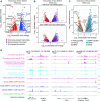


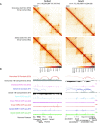
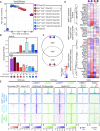
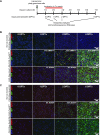


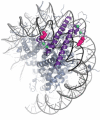
Similar articles
-
Sexual cell-fate reprogramming in the ovary by DMRT1.Curr Biol. 2015 Mar 16;25(6):764-771. doi: 10.1016/j.cub.2015.01.034. Epub 2015 Feb 12. Curr Biol. 2015. PMID: 25683803 Free PMC article.
-
DMRT1 prevents female reprogramming in the postnatal mammalian testis.Nature. 2011 Jul 20;476(7358):101-4. doi: 10.1038/nature10239. Nature. 2011. PMID: 21775990 Free PMC article.
-
Sox9 and Sox8 protect the adult testis from male-to-female genetic reprogramming and complete degeneration.Elife. 2016 Jun 21;5:e15635. doi: 10.7554/eLife.15635. Elife. 2016. PMID: 27328324 Free PMC article.
-
DMRT1: An Ancient Sexual Regulator Required for Human Gonadogenesis.Sex Dev. 2022;16(2-3):112-125. doi: 10.1159/000518272. Epub 2021 Sep 1. Sex Dev. 2022. PMID: 34515237 Free PMC article. Review.
-
The Chromatin State during Gonadal Sex Determination.Sex Dev. 2021;15(5-6):308-316. doi: 10.1159/000520007. Epub 2021 Nov 9. Sex Dev. 2021. PMID: 34753132 Free PMC article. Review.
Cited by
-
DMRT Transcription Factors in the Control of Nervous System Sexual Differentiation.Front Neuroanat. 2022 Jul 26;16:937596. doi: 10.3389/fnana.2022.937596. eCollection 2022. Front Neuroanat. 2022. PMID: 35958734 Free PMC article. Review.
-
FOXL2 interaction with different binding partners regulates the dynamics of ovarian development.Sci Adv. 2024 Mar 22;10(12):eadl0788. doi: 10.1126/sciadv.adl0788. Epub 2024 Mar 22. Sci Adv. 2024. PMID: 38517962 Free PMC article.
-
Loss of NR5A1 in mouse Sertoli cells after sex determination changes cellular identity and induces cell death by anoikis.Development. 2023 Dec 15;150(24):dev201710. doi: 10.1242/dev.201710. Epub 2023 Dec 11. Development. 2023. PMID: 38078651 Free PMC article.
-
The gene regulatory landscape driving mouse gonadal supporting cell differentiation.Sci Adv. 2025 Jul 25;11(30):eadv1885. doi: 10.1126/sciadv.adv1885. Epub 2025 Jul 25. Sci Adv. 2025. PMID: 40712010 Free PMC article.
-
A comparative analysis of genes differentially expressed between rete testis cells and Sertoli cells of the mouse testis.Sci Rep. 2023 Nov 28;13(1):20896. doi: 10.1038/s41598-023-48149-7. Sci Rep. 2023. PMID: 38017073 Free PMC article.
References
-
- Albrecht K.H., Eicher E.M.. Evidence that Sry is expressed in pre-Sertoli cells and Sertoli and granulosa cells have a common precursor. Dev. Biol. 2001; 240:92–107. - PubMed
-
- Stevant I., Kuhne F., Greenfield A., Chaboissier M.C., Dermitzakis E.T., Nef S.. Dissecting cell lineage specification and sex fate determination in gonadal somatic cells using single-cell transcriptomics. Cell Rep. 2019; 26:3272–3283. - PubMed
Publication types
MeSH terms
Substances
Grants and funding
LinkOut - more resources
Full Text Sources
Molecular Biology Databases
Research Materials

